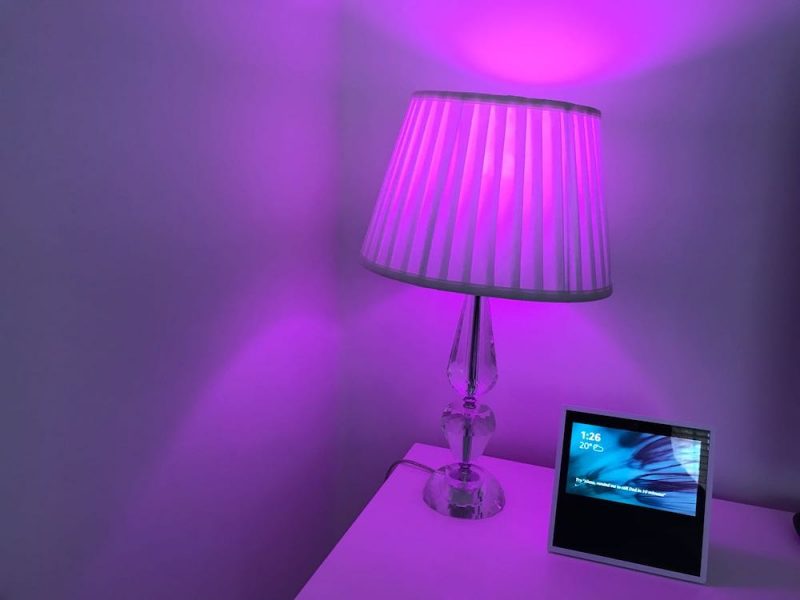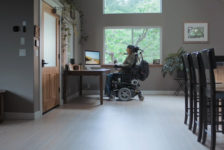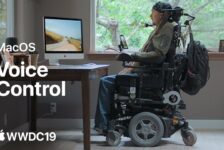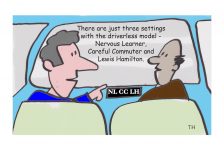Please note there has been an update to this article Waking up to Alexa: 2020 follow-up
Whether it’s bolstering your home security, watering your garden, or turning your lights on and off, smart technology is starting to fill our homes. For some it seems it can be too much like hard work to get off the sofa to even adjust the thermostat. Smart home gadgets now mean smart speakers can play music when you talk to them, you can turn the heating on before you get home, and a smart camera can alert you if there’s an intruder – or even feed your pet for you.
However, for others this increasingly ubiquitous smart home technology does a lot more than simply adding a bit of convenience to our increasingly slothful lives. This was brought home to me at Christmas when I lost my brother Ian, aged 51, to complications of the genetic muscle wasting disease muscular dystrophy. He had been bed-bound for the past 17 years but managed to keep in touch with family and friends with his smartphone. Facebook, SMS, Skype, and Google Duo were the ways that Ian remained in contact with the outside world from his bed.
In the weeks before Christmas Ian contracted a virus, which, combined with heart failure, severely affected his hands and arms rendering him unable to use the gadgets, which were his lifeline to family and friends. By the end of November he was rendered technologically mute, unable even to operate his phone because for him, in his weakened state, it was too large and heavy to hold. He had been a prolific user of Facebook but now, communication without the help of a carer was not an option.
In the autumn I started a project that had been months in the brewing, which was to transform my home into a smart home because I too have muscular dystrophy and was finding controlling my environment impossible; switching lights on and off, opening and closing blinds, controlling the thermostat, to name but a few day-to-day activities many people take for granted. My aim was to control all these activities by voice commands and the gadget I needed to do this was an Amazon Echo Show smart speaker with touchscreen and camera. It was the speech activated device I chose as the gateway to my new smart home.
A week before Christmas I had two of these gadgets up and running and couldn’t wait to tell Ian how useful they were. My objective at that stage was to set everything up successfully in my home and then work with Ian in the New Year to install the same technology in his. Sadly, that was not to be.
However, fate was soon to intervene. Every year myself, Ian, and his twin Alan club together and buy my parents a technology based Christmas present. Last Christmas we decided to buy them an Amazon Echo Show, and by coincidence Ian’s carer also bought him an Echo Show a few days before Christmas as a present.
What this meant to Ian, my parents, and myself was truly transformational. Ian’s Echo Show was placed on a chest of drawers next to his bed. Unable to use his hands anymore to operate his phone the last physical ability he had left in the weeks before he died was his voice, and he used this to direct his Echo Show. He was able to link up with myself and my parents spontaneously from what was about to become his deathbed. He didn’t have to ask a carer to hold a phone to his ear, he didn’t need to struggle to crank up a laptop to log on to Skype; he simply needed to say to the Echo Show “Call Colin,” or “Call Dad” whenever he wanted, and it would call our Echo Shows in Wales and London. Several times in the last few days of his life Ian enjoyed a number of long video conversations, which he initiated himself. I am sure it gave him comfort being able to reach out to us so easily, and I know we will be forever grateful we were able to speak to him and see him right up until the end thanks to this technology.
Amazon Alexa on the NHS
My smart home project started with a broken arm in October 2016. The fracture brought home to me how the progress of my muscular dystrophy, in particular the increasing weakness in my hands and arms, was making it impossible for me to control my environment, and even summon help if necessary. I just don’t have the strength to reliably reach for keyboards, phones, and remote controls. My future, I decided, lay in voice control. It is the one physical asset I can still rely on.
As part of my rehabilitation I was seen by an occupational therapist from my local NHS where we discussed controlling my environment. I was aware that the NHS provides Environmental Control (EC) Services around the country for severely disabled people commissioned by NHS England as specialised prescriber services, in accordance with a national service specification. I asked to be referred to my local EC service in London with a view to getting advice and help in making my home smart so I could control things like thermostat, lights, and blinds, by my voice.
As with every NHS service these days there was a six month wait to be seen but by July 2017 I had my initial assessment with an occupational therapist from my NHS EC service. I was aware of what EC services traditionally offer patients and it often means traditional cabling, sometimes fairly basic custom switches, and infrared controls, all of which I thought of as last century technology, and did not find very appealing aesthetically in a home environment, or practical with my limited physical abilities. I was clear, I wanted to control my environment wirelessly and with my voice.
The NHS, perhaps understandably, is behind the curve when it comes to adopting new technology having to take into account safety considerations, efficacy, and value for money with limited budgets. I was told by the EC service that the subject of smart home control has only just begun to be debated amongst EC services at national level. Conventional EC equipment they supply currently does not offer satisfactory voice recognition, which is sufficiently accurate and easy to use. However, it was explained to me, that a development project and trial of loaned equipment built around smart home devices could be set up for me — but that it was not a routine prescription. It would provide the EC service with an opportunity for operational experience of this type of equipment. However, as a development project, it would not include the same degree of support as usually offered, and that the NHS would only fund those components considered to fall within its tightly prescribed limits.
It is worth highlighting that these limits include the principle that the remit and funding are to assess for and provide the ‘means of access’ to the computer or smart device for individuals where standard means of access (keyboard and mouse, or readily available adapted versions) are not suitable. The remit covers provision of the specialised hardware and/or software and the training required in its use. However, it does not include the computer device itself or any standard hardware/software or basic computer training. Installation preparatory works (e.g. electrician or locksmith/joiner) are also excluded.
What the NHS EC service will fund are the following:
- the EC controller (typically a Class 1 Medical device) and means of access to it (e.g. switch)
- any associated specialist peripheral units for which there is no non-specialist alternative, or where commonality of control signal is required (e.g. remote control telephone, intercom and mains sockets)
- any associated specialist interface units (e.g. for control of profiling beds/chairs) — where there are no other means of control signal interface
- mounting and stands required for the above
In addition, there are some operational requirements on the equipment and the service support framework around it (whether from the NHS or via a contractor), these include:
- battery backup to support operation in case of main electrical failure, up to 4 hours for essential functions
- technical Fault support via telephone and visit — for 48 hr response for functions assessed as requiring this
- maintenance and service support
- continuity of supply (currently requiring 5 year notice of withdrawal of product support)
When it comes to lights the NHS will not fund smart light bulbs or fittings. Despite the fact they are like mini computers with Wi-Fi and last 25 years they are classed as consumables and therefore outside the scope of NHS EC funding. With most homes requiring at least several light bulbs and fittings this is a significant exclusion for many when they can cost anything from £30 — £200 each. Do not expect the NHS to light up your home in technicolour any time soon.
Apple vs Amazon vs Google
There are three main control systems: Amazon Echo, Google Home, and Apple HomeKit. They are not compatible with each other so you need to make sure your device, whether it is a smart door lock, fan, or security camera works with whichever system you go for.
One of the best aspects of involving the NHS EC service was they provided me with access to their assistive technology consultants Hands Free Computing. Whilst I consider myself fairly tech savvy the expert input and advice from Neil at Hands Free Computing proved invaluable as smart home technology is changing so rapidly; one minute a device is not compatible with Apple and the next minute it is, and vice versa with Amazon and Google. It is really difficult to keep track of the pace of change these days.
I started the project thinking my logical speech control method would be through Apple HomeKit, Siri, and the various Apple mobile devices I already own, including iPhone, MacBook, and Apple Watch; how wrong I was. As Neil was to point out early on from his research, Apple has a fairly closed garden when it comes to working with third-party apps, and the smart devices HomeKit works with are limited. In contrast, Amazon has been in the smart home market for longer and has an expanding list of integrations with device manufacturers and skills.
An inventory of all the devices that I wanted to control by voice, including ones I already owned, quickly revealed that only Amazon Alexa was capable of operating all of them so for this reason we went down the Amazon route. Being a self-confessed Apple addict I took some persuading to fill my home with Amazon products but Neil’s research was compelling and in the end going with Amazon was a no-brainer.
Heating

The first environmental function I was able to control by voice commands was my central heating last October 2017. This was made possible by a wireless thermostat from Honeywell that works with both Amazon Alexa and Apple HomeKit. Using Siri on my iPhone or via Amazon Alexa Show I was able to regulate the temperature in my home for the first time in my life. “Hey Siri set the heat to 22 degrees”, “Alexa turn the heating off”, and “Hey Siri turn the heating on”. My social housing landlord installed the thermostat upon a request from the NHS. A quick and easy installation by a professional heating engineer included a receiver connected to my combination boiler in the kitchen, and the wireless thermostat sits on a shelf in my living room. An Alexa skill, and Apple HomeKit compatibility, gave me control via both my Amazon Alexa and Apple devices. I was up and running at last and it was such a good feeling!
Lighting
As Christmas approached I wanted to get all the lighting in my home operated by voice commands. I have never been a person for half measures; if a job’s worth doing it is worth doing well has always been my philosophy. Phillips is the leading company in smart home lighting through their Philips Hue range of bulbs and fittings that work over your home Wi-Fi via a hub. The NHS supplied a Philips Hue starter kit that included a hub that plugs into my Wi-Fi router and two white smart bulbs to get me started. I supplied several Philips Hue light fittings and a selection of bulbs for lamps that I have in various rooms, which means that practically every room now has lighting I can switch on off, and dim, by my voice. I hired a local electrician to install the light fittings and pairing them, and the various light bulbs, with the Philips Hue bridge was very easy indeed.
The NHS also supplied two motion sensors, which work with Phillips Hue lights and bulbs. I had high hopes for these but despite being able to be configured in all kinds of ways I can’t get them to work to everyone’s convenience in my home of multiple occupancy. If I lived on my own I can see to go into the bedroom and for the light to come on as the sensor is triggered would be very useful but with people around me all the time the constant triggering of lights by the sensor is very inconvenient.
The one small but significant issue I am experiencing is that all the light switches in my flat at the moment are conventional ones. The way that Phillips Hue bulbs and fittings work is that if they are switched off manually at the wall, they cannot be switched back on by voice. So, for example, if my carer switches off a light at the wall with my traditional wall switch, and goes out for a couple of hours, and she and I do not realise the switch is off at the wall, I cannot switch the light back on by my voice. I’m stuck right back where I was before I started this process. This applies to every light switch in the home. This also applies not only to my carers but also guests. It is a natural tendency for people to switch lights off at the wall.
Alexa powered light switches and wall sockets, such as those from LightwaveRF, will solve this problem at a stroke but at considerable cost. To convert all my switches and wall power sockets, including an electrician to carry out the work, would cost over £2,000. Even if these Alexa switches and sockets are switched off manually I can switch them on by voice, that is the key advantage. I would like full control over all my lights and power sockets to manage my energy consumption as well as maintain my independence. Alexa compatible switches and power sockets would really iron out inconveniences I have been experiencing and prevent me being left stuck with no voice management. It is worth noting that Alexa sockets and light switches will work normally and manually as traditional switches and sockets.
Blinds
For several years I have had battery powered electric motorised blinds by the leading manufacturer in the sector Somfy. This was good fortune because to take control of the eight blinds in my flat by voice control all I needed was a Tahoma hub that the NHS EC service supplied and is another little box that plugs into my Wi-Fi router and communicates with my blinds. It was also good fortune that as we started the project last autumn Somfy announced that its Tahoma hub would be compatible with Alexa allowing me to operate my blinds by voice. Set up is not that easy and I was grateful to have Neil from Hands Free Computing around to help me.
Television
Another thing I have had increasing problems with in recent years is handling the Sky TV remote control because it is to heavy. To control my LG Smart television, Sky satellite box, and Amazon Fire TV by speech commands I got myself a Logitech Harmony Hub. This small puck of a box sits next to my television and connects to non-Wi-Fi enabled entertainment systems, and smart home devices, using IR, Bluetooth and Wi-Fi wireless protocols, to control smart devices through a Harmony app, Android and iOS. The Harmony Hub turns your smartphone or tablet into a universal remote, giving you control over your home entertainment and smart home devices. You can change channels and volume, program favourites, control lights and other smart devices. With Harmony and Amazon Alexa, you can enjoy hands-free voice control. Turn on the TV, change channels or turn up the volume, your voice makes it all work, just like magic. I set up the Harmony Hub by myself with the help of my carer and it does take a couple of hours to get things running smoothly.
The one downside with the Harmony Hub is you cannot control two televisions by voice through one Amazon Alexa account. Even buying a second Harmony Hub wouldn’t solve this problem. With most households having several TVs this is surely an issue that Logitech must be looking at.
Another option to get round this problem that I’m considering is buying a new television that works with Alexa for my living room where I don’t have voice control over my TV at the moment. There are a few Android televisions from Sony on the market and with this type of TV I can connect my Amazon Alexa enabled devices for seamless hands-free voice control — power up the TV, change channels, control volume and more.
Stick the kettle on, love
In all my life I have never been asked to do this that is uttered in millions of households every day but that changed a few weeks ago when the element went on my conventional DeLonghi kettle. With no option but to get a new one I decided to go for a kettle I can control by speech commands. One of the best on the market at the moment that works with Alexa is the iKettle from Smarter. Incredibly easy to set up via a iOS app, and Alexa skill, in next to no time I was saying: “Alexa, turn on the kettle” and as if by magic I was able for the first time in by life to put the kettle on for myself and guests. Of course it still won’t pour a cup of tea or coffee, and I still need someone to fill the kettle with water, but it is certainly a step forward. Some may scoff at the thought of a voice-controlled gadget that still needs another person’s intervention at all stages bar one. However, there is nothing frivolous and superfluous about this purchase. Now, if I fancy a cuppa, I can do it myself, when I feel like it, and it is ready for my carer to pour when I want to have a brew. It’s a first step on a road to a more independent future. Unless one is sat in my shoes it is difficult to empathise with the joy of being able to do something everyone else does ten times a day on auto pilot. The kettle is the gadget that has given me the greatest psychological buzz and whilst not entirely useful it is symbolic of an increasing independence.
Door
I have an automatic electric door opener fixed to my front door. Manufactured by Record, who make many of the automatic door openers you see in shops and office buildings, it works by a radio remote control unit, which when pressed opens and closes my front door so I can get out on my own. It is really useful and is my only means of access and exit because opening and closing my own front door is impossible because of the weakness in my hands and arms. But reaching for the remote control is proving difficult and I was looking for a way of opening and closing my front door by my voice. We approached the original supplier of my automatic door opener who confirmed it would be possible to automate my front door to be operated via Apple HomeKit and Siri voice commands but they wanted more than £4,000 to make this happen! Once installed the procedure to use it would be as follows: a visitor will use a video entry kit, I will then grant access via Apple HomeKit and Siri, which will then send a command to an August Smart Lock to unlock the door. Once the smart lock has unlocked, using a relay signal/switch to be given to maglock to de-energise/release, my door opener will either pull or push the door open. Once fully opened the door will then after a short period of time close. Once closed the August Smart Lock will lock the door.
For readers not familiar with the disability, technology, and equipment sector it is worth highlighting that there has been a racket going on for decades where anything that is labelled as “special” or for “special needs” has a premium placed on the price. I don’t think any government has done anything much about this and as a purchaser itself successive governments appear to turn a blind eye to what this sector is doing. I think the high cost of disability technology and equipment should come under more scrutiny than it does. Disabled consumers, often strapped for cash because they’re living on state benefits, are getting a very bad deal at the moment.
Routines
One of the most powerful features of this smart home technology are “routines”. Amazon Alexa routines allow the voice assistant to complete multiple tasks with a single voice command. When I wake up in the morning I say “Alexa good morning” and from this single phrase my Echo Show will turn on my bedside table lamp, read and show me the weather, turn on the television to my favourite channel, and boil the kettle. Now that is a real sense of power!
Routines also get around the problem of having to remember many individual voice commands, which I found challenging at the beginning. It’s worth noting at this point that voice control is not for every disabled person. There will be those with learning disabilities, or lack of speech as the result of a stroke, for example, who may find it difficult accessing smart speakers for voice control.
Not Blofeld

MGM
Having this technology in my home has amazed and enthralled visitors but it doesn’t make me feel or look like Blofeld, the fictional wheelchair-bound character and villain from the James Bond films. I do have a cat but lack the sharks and a fish tank.
Almost every room in my home is now wired with Amazon devices to control my heat, lights, blinds, kettle, and TV, which are wireless, discreet, and easy on the eye. The technology has given me a sense of power and independence I have never felt in my life before. This surely must be a good thing for people who hitherto have felt powerless and trapped in a useless body.
Stories of Amazon Alexa hearing and sending private chats have not raised privacy concerns because for me the independence this technology gives me far outweighs any privacy concerns I may have. It’s a risk I consider worth taking, and I take some sensible precautions such as giving my Wi-Fi network an extremely strong password.
Reliability has not been a problem. Living in central London I have a fast and reliable internet connection, and electricity supply, so there have been very few glitches or downtimes. I realise if Armageddon comes I am up the creek without a paddle but wouldn’t we all be?
Alexa can be annoying sometimes when voices on television, or conversations with visitors, can trigger an unwanted response from the smart speaker. Amazon needs to do more to prevent this happening, possibly through having individual voice profiles, which is something it does not have at the moment in the UK. Alexa will respond to anyone’s voice, which highlights the susceptibility of these gadgets to do some fairly random and bizarre things.
Whilst there appears to be almost no limit to the smart home devices that will work with Amazon Alexa, Apple is still trailing far behind. Apple added support in iOS 11.3 for HomeKit software authentication yet still my Somfy blinds and Smarter iKettle will not work with Siri. Both manufacturers are saying the compatibility is coming sometime in 2018. HomeKit software authentication means that smart home manufacturers, such as Somfy and Smarter, don’t have to change the hardware and bring out new products to become HomeKit enabled, it can be done via software.
As part of the experiment the NHS EC service supplied me with two smart speakers an Amazon Echo and an Amazon Echo Plus. I supplied two of the more expensive Echo Shows myself so that more rooms in my home could have a smart speaker. I find an Amazon Echo speaker with a screen and camera more helpful than one without.
Having a smart speaker in almost every room has given me an added sense of personal security. My carer leaves me on my own at home from time to time to run an errand, go to the shops, and so on. I welcome the time and space to myself but with my hands and arms getting weaker in recent years I have worried about whether I would be able to reach my phone in an emergency. With a smart speaker always handy I no longer need to worry about this. I just ask Alexa if I need to call someone for help from anywhere in my home at any time.
I like the look of these smart home gadgets. Like many disabled people I hate it when things look like they’re for people with disabilities. They are unobtrusive, mainstream, and fit nicely in my home but just happen to have features extremely useful for me. This should be the essence of inclusive technological design when it comes to disability. The brilliant engineers that work in these tech companies like Amazon, Apple, Google and Microsoft need to think of people’s disabilities not as something for which they need to create bespoke designs, but instead make their products even easier to use for everyone.
Whilst I was really grateful my local EC service gave me the chance to take part in an experimental project like this I do feel that the NHS generally is lagging behind this rapidly developing technological revolution. The costs of these gadgets and products are still expensive especially for most disabled people who could benefit most from it. Many are statistically likely to be on state benefits and unable to afford much of it. Even with the supply of some equipment by the NHS I have still spent approximately £1,000 of my own money to reach the positive situation I am in now because of so many exclusions in provision. This has been the personal price of significantly increasing my independence. That is a rather sad fact and a poor reflection on the welfare state.
The expertise and the equipment with which my local NHS EC service supplied me as part of this trial has been really helpful and appreciated but the broader NHS EC system for the most severely physically disabled who want to control their environment by voice commands needs to change. I hope this trial will influence and inform change more widely. Only supplying the ‘means of access’ technology, and not the devices themselves, is obviously helpful for NHS budgets but it doesn’t do anywhere near enough for users who cannot afford the expensive gadgets that are needed to truly take control of their home environment.
I feel what I have had to pay is a tax on my health and I already pay enough tax into the system. I know people with severe disabilities who could really benefit from this technology who would not have access to £1,000 to transform their homes into smart homes. Most life-transforming NHS procedures cost several thousand pounds such as hip replacements, heart valve replacements, electric wheelchairs, and artificial legs. Taxpayers when they need new hips and heart valves expect the NHS to pick up the tab. I do not know what the average unit spend is on environmental control equipment but a thousand pounds does not seem a lot to me in comparison to other treatments, and as my trial has shown it does make a big impact on independence and personal security.
This technology could end up saving the NHS money in the future by reducing the mundane tasks nurses and carers have to carry out for their patients. How long will it be until you are lying in a hospital bed and instead of asking a nurse you ask Amazon Alexa to give you a drink, close the blinds, turn the TV on, and dispense your medication. Someone somewhere deep in a large organisation like the NHS must surely be blue sky thinking along similar lines at the moment.
Automating my life through technology this past six months has given me a glimpse of a future I yearn for. Whilst I have great relationships and friendships with my carers there are times, first thing in the morning for example, where I’d rather not talk about the weather, or last night’s soaps, while someone is putting on my shirt, or giving me a wash. How long before I can engage an android to carry out these personal care tasks? I often wonder is automating the delivery of social care something that Google or Uber are looking at or are they too busy automating cars?
Amazon, Google, and Apple, the main players in the smart home market, make huge profits from consumers but for some their technology is not about a bit of added convenience to daily life, it can be truly life transforming — if only you can afford it. Should these tech giants be doing more to make their products available to the most severely disabled and disadvantaged? As profit-driven organisations they are, perhaps understandably, not very good at doing social good but in the UK building companies are required to provide cheap social housing if they want to build lucrative developments for richer clients in some areas. Along similar lines, I believe the time has come for these tech companies to be forced in some way to set aside some of their vast profits for social good. Perhaps as governments around the world look at ways of curbing their excesses something along similar lines could be considered.
Over the past few years, the big players in the tech industry have added some accessibility features to their products, which has to be acknowledged and welcomed. Apple added an activity tracker its Apple Watch for wheelchair users. Google added features to make their phones easier to hear and read. But while these initiatives are welcome it all feels a little tokenistic compared to the billions each of them make in profits each year. The truth is a lot of the people who could benefit from accessibility features simply cannot afford the devices.
When Microsoft said recently it is to release the first ever controller designed and made specifically for disabled gamers it was an innovation to be applauded but it is rumoured the mighty tech giant is going to sell it for £20 more than the cost of an average games controller. Could philanthropic billionaire Bill Gates and his highly profitable company Microsoft have absorbed this cost for the relatively few people it would benefit? Too right it could. Is there a legal responsibility to do so? Sadly, no. Is there an ethical reason to do so? A resounding yes in my humble opinion.
Conclusion
When billions of people on the planet each day use their products, generating huge profits, I do think these tech companies have a social responsibility to make their technology accessible and affordable to the most severely disabled. If they spent less time on minimising their tax liabilities the world would be a better and fairer place.
The World Health Organisation estimates more than one billion people require assistive technology, while 90 per cent of these have no access to it. I am at one with the WHO in believing assistive technology should be an important pillar of universal health coverage around the world.
It should never be the case that those who have the privilege of income benefit from this life changing technology, and those that don’t live much less independent lives. I realise we need to tread carefully as any kind of tax can be detrimental to innovation but as my last few conversations with Ian via the Amazon Alexa Show illustrate you cannot put a price on the benefits of this technology.
My humble suggestion to the biggest tech giants Amazon, Google, Apple, and Microsoft is to join together and set up a global accessible technology fund to help severely disabled people access their expensive technologies. If each of them pledged just one percent of their hefty profits to such a laudable venture it would transform lives. It is highly unlikely to happen, world financiers who back them would block it, but what a nice idea it would be if it did. I believe it is perfectly possible to innovate and make great technology with a social responsibility.
Everyone deserves to enjoy a full and active life. People with long-term incurable illnesses often don’t live in hope that science will find us a cure. What we really need is technology to liberate us and allow us to fly as high as we can go in our lives because technology inspires, and levels the playing field. You are only reading this article because I am using voice recognition software to dictate the words on to this page.
Once upon a time I was a little boy sat in a wheelchair with an incurable illness dreaming of becoming a television producer on network television. Thanks to technology that dream came true. For many people like me the thing that stops us living the best lives we can is a lack of accessible and affordable technology.
So for all the little boys and girls in the world sat in wheelchairs and trapped in bodies that don’t work, dreaming of becoming a theoretical physicist, astronaut or indeed a television producer, don’t price them out of their future, give them the technology to help them make their dreams come true.
This is why this stuff matters.






